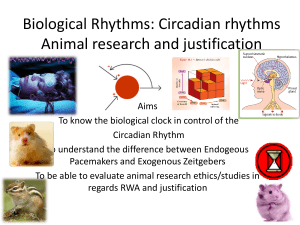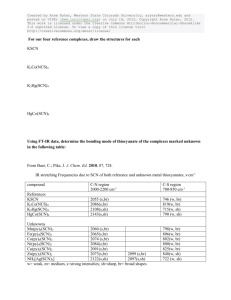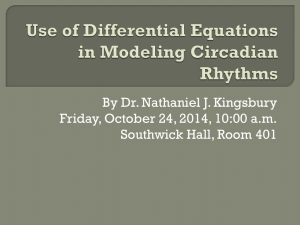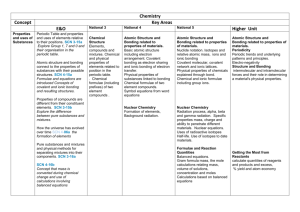Samenvatting proefschrift
advertisement
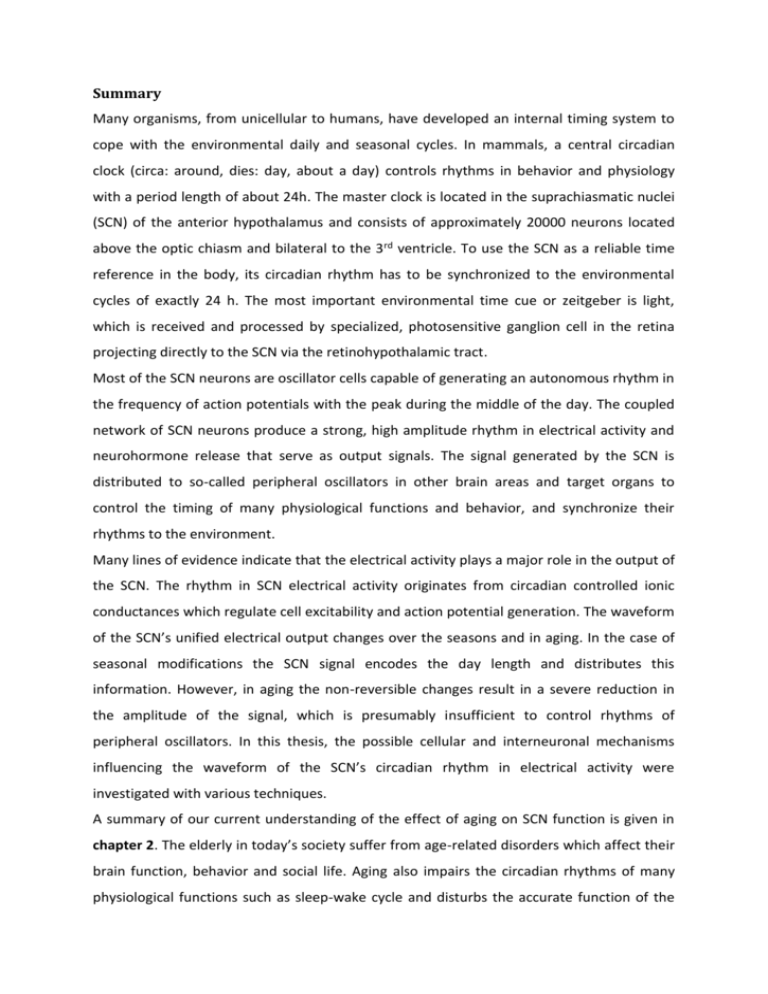
Summary Many organisms, from unicellular to humans, have developed an internal timing system to cope with the environmental daily and seasonal cycles. In mammals, a central circadian clock (circa: around, dies: day, about a day) controls rhythms in behavior and physiology with a period length of about 24h. The master clock is located in the suprachiasmatic nuclei (SCN) of the anterior hypothalamus and consists of approximately 20000 neurons located above the optic chiasm and bilateral to the 3rd ventricle. To use the SCN as a reliable time reference in the body, its circadian rhythm has to be synchronized to the environmental cycles of exactly 24 h. The most important environmental time cue or zeitgeber is light, which is received and processed by specialized, photosensitive ganglion cell in the retina projecting directly to the SCN via the retinohypothalamic tract. Most of the SCN neurons are oscillator cells capable of generating an autonomous rhythm in the frequency of action potentials with the peak during the middle of the day. The coupled network of SCN neurons produce a strong, high amplitude rhythm in electrical activity and neurohormone release that serve as output signals. The signal generated by the SCN is distributed to so-called peripheral oscillators in other brain areas and target organs to control the timing of many physiological functions and behavior, and synchronize their rhythms to the environment. Many lines of evidence indicate that the electrical activity plays a major role in the output of the SCN. The rhythm in SCN electrical activity originates from circadian controlled ionic conductances which regulate cell excitability and action potential generation. The waveform of the SCN’s unified electrical output changes over the seasons and in aging. In the case of seasonal modifications the SCN signal encodes the day length and distributes this information. However, in aging the non-reversible changes result in a severe reduction in the amplitude of the signal, which is presumably insufficient to control rhythms of peripheral oscillators. In this thesis, the possible cellular and interneuronal mechanisms influencing the waveform of the SCN’s circadian rhythm in electrical activity were investigated with various techniques. A summary of our current understanding of the effect of aging on SCN function is given in chapter 2. The elderly in today’s society suffer from age-related disorders which affect their brain function, behavior and social life. Aging also impairs the circadian rhythms of many physiological functions such as sleep-wake cycle and disturbs the accurate function of the SCN. Recently, a great deal of evidence has been presented that link the circadian clock and its proper function to mental and physical health. The aging related deficits in clock function therefore aggravate the health problems of the elderly, hence improvement of clock function can aid healthy aging. Deficits in the function of the aged SCN have been indicated in many studies, but the underlying mechanisms are not known yet. In chapter 3, first a longitudinal study of running wheel behavior from mice between 3 and 30 month of age revealed a distinct time course of age related changes in period length, duration of activity and fragmentation of the locomotor activity. The question if the SCN is determining this behavioral phenotype was addressed with multiunit recordings of the SCN electrical activity in vitro in young (3-6 month) and old mice (>24 month). The distribution of electrical activity within the SCN network was greatly disturbed with a population of neurons active during the night, which is in anti-phase to the main cluster of neurons active in the middle of the day. This resulted in a reduced amplitude of the ensemble electrical activity rhythm. Similar broad phase distribution of SCN neuronal activity patterns has previously been shown to reduce the phase shifting capacity of the SCN. In aging consequently, I demonstrated that the phase shifting capacity to a light-pulse is reduced. Patch-clamp recordings of membrane properties, voltage-dependent K currents and GABAergic postsynaptic currents in SCN neurons revealed the highest degree of age-induced dysfunctions at the cellular level. The circadian control of voltage-dependent K+ currents was selectively affected by age. I found a lack of circadian modulation in fast-delayed rectifier K+ current (FDR) and the transient K+ current (IA), which may contribute to the increase in neuronal activity during the night and to the decrease in firing frequency during the day respectively. The results of this chapter suggest that modification in cellular characteristics and intercellular communication may cause the alterations in the network level and lead to a defective behavioral function such as sleep problems and fragmented locomotor activity. Remarkably, the adverse age-related cellular changes are partly compensated on the network level. To further investigate the role of the circadian controlled K+ currents in attenuation of the SCN electrical rhythm amplitude during aging, I measured the large conductance calcium activated potassium currents (BK) in chapter 4. BK currents are essential for normal SCN electrical activity pattern, and proper behavioral and physiological rhythms. BK channel deficient mice show a similar phenotype as aged mice in some aspects such as the reduction in total behavioral activity, a reduced stability and precision of behavioral rhythm, a moderate lengthening of the circadian period and an altered SCN electrical activity. Patch clamp and calcium imaging recordings in old mice indicated a loss in rhythmic modulation of BK currents and a reversed rhythm in intracellular calcium concentration ([Ca 2+]i). The BK current was reduced in magnitude at night compared with the young group. Bk channels in many neurons contribute to action potential waveform and can change [Ca 2+]i. The decrease in BK current in aged SCN neurons at night was indeed found to be associated with a depolarization of the membrane potential, a prolonged action potential repolarization, a reduced afterhyperpolarization potential and an elevated [Ca2+]i. These data indicate that age-related reduction of BK currents at night modifies the action potential waveform in SCN neurons. The accurate shape of action potential determines the amount of Ca 2+ influx through voltage gated Ca2+ channels during neuronal activity. A prolonged spike repolarization longer activates the voltage gated Ca2+ channels or a reduced AHP delays the deactivation of Ca2+ channels and cause an increased Ca2+ entry and elevated [Ca2+]i. The results of this study suggest that changes of BK currents and subsequently in action potential waveform can contribute to increased [Ca2+]i at night and to the aged SCN phenotype. Chapter 5 discusses the cellular basis of seasonal adaptation by the SCN. The SCN encodes seasonal changes in day-length by modulating the phase distribution of electrical activity patterns of individual neurons. The collective electrical pattern of the SCN determines the waveform of the SCN electrical activity, and hence the duration of behavioral activity. In a nocturnal animal adaptation to a long-day photoperiod, results in a more distributed electrical pattern and a short duration of behavioral activity while exposure to a short-day photoperiod enhanced phase synchrony among neurons results in longer activity pattern. In this way, the SCN, in concert with other brain regions involved in seasonal adaptation, e.g. pineal gland, controls the seasonal behavior. While some of the mechanisms underlying this neuronal phase adjustment in different photoperiods in the SCN, like a role for VIP, have been described, little is known about the cellular mechanisms. Using patch clamp technique, passive and active membrane properties of single neurons such as firing frequency, membrane potential and input resistance were measured in long-day (LD16:8) and shortday (LD 8:16) photoperiods. The results of this study indicate that these cellular properties are similar in the different photoperiods. Remarkably, among the various K+ currents that we measured, only the FDR current was influenced by changes in photoperiod. The FDR current is known to influence behavioral activity rhythms and modulate electrical activity rhythms. It also affects photic information processing within the SCN. There is evidence that the magnitude of the FDR current is affected by light-mediated stimuli and is necessary for photic regulation of gene expression within the SCN. In chapter 5 I have shown that the FDR current is elevated during the night in long-day photoperiod and the daily rhythm in FDR current is reversed in this photoperiod. However, the functional role of the FDR current in photoperiodic adaptation is not clear. In the SCN, long-range synchronization between dorsal and ventral parts of the SCN was suggested to be weakened in long-day photoperiod, which may allow for a wider phase distribution within the SCN network. The FDR current has a potential role in intercellular synchronization in the SCN as it was shown for other brain regions (i.e. neocortex). The precise role of FDR currents in photoperiodic adaptation needs further investigations. Consistent with previous studies, the electrical output and membrane properties of single cells do not change in the photoperiodic adaptation. Photoperiodic phase adjustment therefore, is more likely to be caused by a modified intercellular communications. GABA is one of the main neurotransmitters within the SCN. To understand the role of GABA in seasonal adaptation, GABAergic signaling in the SCN was investigated after adaptation to long- and short-day photoperiods. Chapter 6 describes GABAergic activity and responses, using patch clamp and calcium imaging recordings, in suprachiasmatic neurons of mice exposed to long-day or short-day photoperiod. Exposure to short-day photoperiod decreased the frequency of spontaneous GABAergic synaptic events compared to long-day photoperiod. Importantly, we found enhanced GABAergic excitatory responses in circadian clock neurons of mice exposed to long days (40%) as compared to short days (28%). A precise balance between GABAergic excitation and inhibition in the SCN neuronal network may play a considerable role in adjusting the phase distribution to encode and convey photoperiodic information in the SCN. Photoperiod seems to have influence on basic biophysical properties of the clock cell physiology, changing the concentration of intracellular Cl- by regulating activity of Cl- cotransporter, which subsequently will lead to a shift in the GABA equilibrium potential. Environmental cues such as daylight can thus affect the function of GABA as a key neurotransmitter in the SCN. Daylight or other environmental signals may also influence the function of GABA or other neurotransmitters and thereby the balance between excitation and inhibition in the central nervous system. Plasticity in the circadian clock organization is needed for adaptation to environmental challenges. But, this thesis also emphasizes the importance of the circadian system for health. Life style in modern societies influence our brain in different ways than the natural environment would. Artificial prolonged light duration can affect the neurotransmitter system in the brain. This has been demonstrated for the SCN in this thesis and for other hypothalamic nuclei in a previous study, observing a switch in neurotransmitter content with a correlated change in anxiety behavior. The neuronal strategies which the SCN uses to adapt to various photoperiods, has been evolved in mammals to help the organisms to anticipate seasonal changes and adjust their behavior to the corresponding environmental challenges. However artificial prolonged light in the evening may keep our clocks in a continuous mode of long summer days, which may have detrimental effects on our physiology and behavior. While the effect of seasonal changes in photoperiod are reversible, aging irreversibly affects different levels of the clock machinery from molecular rhythms, intracellular signaling and membrane properties to intercellular communication, neuronal network synchronization and behavioral function. As a result, the amplitude of the circadian timing signal is reduced, peripheral oscillators are weakened and the accuracy of daily rhythms in physiology and behavior is decreased. Restoration of the deficiencies in cellular and intercellular functions may help to achieve healthy aging and mitigate agerelated diseases provoked by clock dysfunction.
